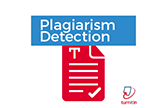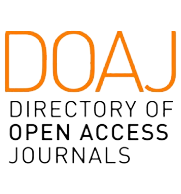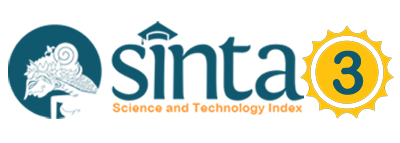Classifying Mt. Etna Lava Flows using PlanetScope Image and U-Net-based Deep Learning
Abstract
Full Text:
PDFReferences
Allard, P., Behncke, B., Amico, S. D., Neri, M., & Gambino, S. (2006). Mount Etna 1993 – 2005 : Anatomy of an evolving eruptive cycle. Earth-Science Reviews, 78, 85–114.
Andronico, D., Branca, S., Calvari, S., Burton, M., Caltabiano, T., Anna, R., Paola, C., Carlo, D., Garfì, G., Lodato, L., Miraglia, L., Mur, F., Neri, M., Pecora, E., & Pompilio, M. (2005). A multi-disciplinary study of the 2002 – 03 Etna eruption : insights into a complex plumbing system. Bulletin of Volcanology, 314–330.
Acocella, V., Neri, M., Behncke, B., Bonforte, A., Del Negro, C., & Ganci, G. (2016). Why does a mature volcano need new vents? The case of the new Southeast crater at Etna. Frontiers in Earth Science, 4(June), 1–16.
Corradino, C., Ganci, G., Cappello, A., Bilotta, G., Hérault, A., & Del Negro, C. (2019). Mapping recent lava flows at Mount Etna using multispectral Sentinel-2 images and machine learning techniques. Remote Sensing, 11(16).
Sciotto, M., Cannata, A., Gresta, S., Privitera, E., & Spina, L. (2013). Seismic and infrasound signals at Mt. Etna: Modeling the North-East crater conduit and its relation with the 2008-2009 eruption feeding system. Journal of Volcanology and Geothermal Research, 254, 53–68.
Behncke, B., Branca, S., Corsaro, R. A., Beni, E. De, Miraglia, L., & Proietti, C. (2014). The 2011 – 2012 summit activity of Mount Etna : Birth , growth and products of the new SE crater ☆. Journal of Volcanology and Geothermal Research, 270, 10–21.
Cashman, K. V., Soule, S. A., Mackey, B. H., Deligne, N. I., Deardorff, N. D., & Dietterich, H. R. (2013). How lava flows: New insights from applications of lidar technologies to lava flow studies. Geosphere, 9(6), 1664–1680.
Head, E. M., Maclean, A. L., & Carn, S. A. (2013). Mapping lava flows from Nyamuragira volcano (1967-2011) with satellite data and automated classification methods. Geomatics, Natural Hazards and Risk, 4(2), 119–144.
De Beni, E., Cantarero, M., Neri, M., & Messina, A. (2021). Lava flows of Mt Etna, Italy: the 2019 eruption within the context of the last two decades (1999–2019). Journal of Maps, 17(3), 65–76.
Ganci, G., Cappello, A., Bilotta, G., & Del Negro, C. (2020). How the variety of satellite remote sensing data over volcanoes can assist hazard monitoring efforts: The 2011 eruption of Nabro volcano. Remote Sensing of Environment, 236(September 2019).
Dietterich, H. R., Poland, M. P., Schmidt, D. A., Cashman, K. V., Sherrod, D. R., & Espinosa, A. T. (2012). Tracking lava flow emplacement on the east rift zone of Klauea, Hawaii, with synthetic aperture radar coherence. Geochemistry, Geophysics, Geosystems, 13(5), 1–17.
Lu, Z., Fielding, E., Patrick, M. R., & Trautwein, C. M. (2003). Estimating lava volume by precision combination of multiple baseline spaceborne and airborne interferometric synthetic aperture radar: The 1997 eruption of Okmok Volcano, Alaska. IEEE Transactions on Geoscience and Remote Sensing, 41(6 PART I), 1428–1436.
Amato, E., Corradino, C., Torrisi, F., & Del Negro, C. (2021). Mapping lava flows at Etna Volcano using Google Earth Engine, open-access satellite data, and machine learning. International Conference on Electrical, Computer, Communications and Mechatronics Engineering, ICECCME 2021, October, 7–8.
Corradino, C., Ramsey, M. S., Pailot-Bonnetat, S., Harris, A. J. L., & Negro, C. Del. (2023). Detection of Subtle Thermal Anomalies: Deep Learning Applied to the ASTER Global Volcano Dataset. IEEE Transactions on Geoscience and Remote Sensing, 61.
Torrisi, F., Amato, E., Corradino, C., Mangiagli, S., & Del Negro, C. (2022). Characterization of Volcanic Cloud Components Using Machine Learning Techniques and SEVIRI Infrared Images. Sensors, 22(20), 1–19.
Temenos, A., Temenos, N., Doulamis, A., & Doulamis, N. (2022). On the Exploration of Automatic Building Extraction from RGB Satellite Images Using Deep Learning Architectures Based on U-Net. Technologies, 10(1), 19.
Diaz, J., Cervone, G., & Wauthier, C. (2021). Improving the Thermal Infrared Monitoring of Volcanoes: A Deep Learning Approach for Intermittent Image Series. Journal of Latex Class Files, 14(8), 1–18.
De Plaen, R. S. M., Cannata, A., Cannavo’, F., Caudron, C., Lecocq, T., & Francis, O. (2019). Temporal changes of seismic velocity caused by volcanic activity at Mt. Etna revealed by the autocorrelation of ambient seismic noise. Frontiers in Earth Science, 6(January), 1–11.
Neri, M., Acocella, V., Behncke, B., Maiolino, V., Ursino, A., & Velardita, R. (2005). Contrasting triggering mechanisms of the 2001 and 2002-2003 eruptions of Mount Etna (Italy). Journal of Volcanology and Geothermal Research, 144(1-4 SPEC. ISS.), 235–255.
Global Volcanism Program. (2023). Report on Mt. Etna (Italy). Distributed by Smithsonian Institution, Compiled by Venzke, E.
Tanguy, J. C., Condomines, M., Branca, S., La Delfa, S., & Coltelli, M. (2012). New archeomagnetic and 226Ra- 230Th dating of recent lavas for the Geological map of Etna volcano. Italian Journal of Geosciences, 131(2), 241–257.
Clocchiatti, R., Condomines, M., Guénot, N., & Tanguy, J. C. (2004). Magma changes at Mount Etna: The 2001 and 2002-2003 eruptions. Earth and Planetary Science Letters, 226(3–4), 397–414.
De Beni, E., Cantarero, M., & Messina, A. (2019). UAVs for volcano monitoring: A new approach applied on an active lava flow on Mt. Etna (Italy), during the 27 February–02 March 2017 eruption. Journal of Volcanology and Geothermal Research, 369(March 2017), 250–262.
Abd-Elrahman, A., Britt, K., & Liu, T. (2021). Deep Learning Classification of High-Resolution Drone Images Using the ArcGIS Pro Software. Edis, 2021(5), 1–7.
Malik, K., Robertson, C., Braun, D., & Greig, C. (2021). U-Net convolutional neural network models for detecting and quantifying placer mining disturbances at watershed scales. International Journal of Applied Earth Observation and Geoinformation, 104(August), 102510.
Maxwell, A. E., Warner, T. A., & Guillén, L. A. (2021). Accuracy assessment in convolutional neural network-based deep learning remote sensing studies—part 1: Literature review. Remote Sensing, 13(13), 2450.
Marchese, F., Genzano, N., Neri, M., Falconieri, A., Mazzeo, G., & Pergola, N. (2019). A multi-channel algorithm for mapping volcanic thermal anomalies by means of sentinel-2 MSI and Landsat-8 OLI data. Remote Sensing, 11(23).
Guerrero Tello, J. F., Coltelli, M., Marsella, M., Celauro, A., & Palenzuela Baena, J. A. (2022). Convolutional Neural Network Algorithms for Semantic Segmentation of Volcanic Ash Plumes Using Visible Camera Imagery. Remote Sensing, 14(18).
DOI: https://doi.org/10.17509/wafi.v10i1.85231
Refbacks
- There are currently no refbacks.
Copyright (c) 2025 Wahana Fisika

This work is licensed under a Creative Commons Attribution-ShareAlike 4.0 International License.
Wahana Fisika e-ISSN : 2549-1989 (SK no. 0005.25491989/JI.3.1/SK.ISSN/2017.02 ) published by Physics Program , Universitas Pendidikan Indonesia Jl. Dr.Setiabudhi 229 Bandung. The journal is indexed by DOAJ (Directory of Open Access Journal) SINTA and Google Scholar. Contact: Here
 Lisensi : Creative Commons Attribution-ShareAlike 4.0 International License.
Lisensi : Creative Commons Attribution-ShareAlike 4.0 International License.







.png)